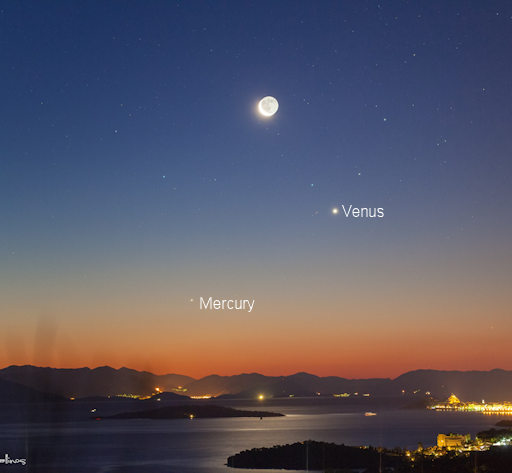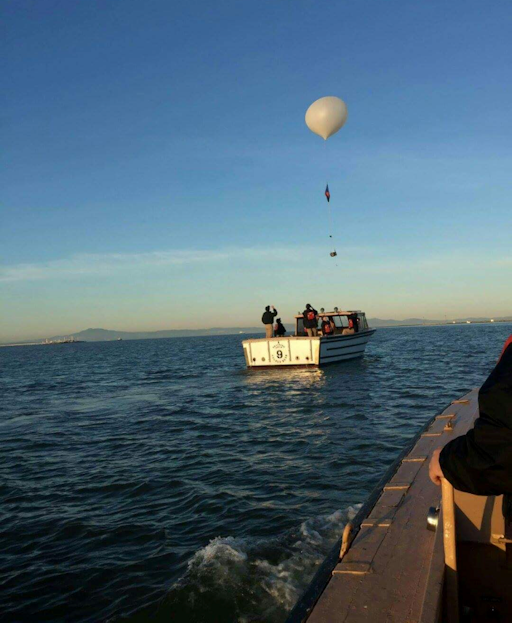Marianne's Heaven On Earth Aurora Chaser Tours Chasethelighttours.co.uk invites you to join them in their quest to find and photograph the Aurora Borealis. Experience the winter wonderland in the Tromsø Area. | | | SOLAR SECTOR BOUNDARY CROSSING: NOAA forecasters estimate a 40% chance of polar geomagnetic storms on Feb 8th when Earth crosses through a fold in the heliospheric current sheet. This is called a "solar sector boundary crossing," and it could spark bright auroras around the Arctic Circle. Aurora alerts: text or voice MORNING PLANETS: Waking up before sunrise can be hard to do. This weekend it has its rewards. Venus, Mercury and the slender crescent Moon have converged in the pre-dawn sky for a beautiful conjunction. Bill Metallinos photographed the gathering over Corfu, Greece, on Feb. 6th: 
"Venus was almost directly above the old Fortress of Corfu, while little Mercury hovered over the urban lights of Igoumenitsa," says Metallinos. "Waking up to this was a pleasure indeed." Set your alarm for about 1/2 hour before dawn, and look east for a beautiful view: sky map, photo gallery. Realtime Spaceweather Photo Gallery SEA LAUNCH OF A SPACE WEATHER BALLOON: For the first time, a space weather balloon has been launched from the deck of a moving boat. Led by Earth to Sky Calculus graduate Aaron Lamb, students at the California State University Maritime Academy did it on Feb. 3rd: 
"It was a complicated launch, but we pulled it off," says Midshipman Lamb. "We sailed with the wind to nullify the effect of wind gusts on the balloon. This allowed us to release it in a controlled manner. A second boat followed us to photograph the launch and to provide any necessary rescues in case of 'men overboard.'" This sea launch is good training for next year's Solar Eclipse Balloon Network: In Aug. 2017 there will be a total eclipse of the sun across the continental United States. Spaceweather.com and the students of Earth to Sky Calculus plan to launch a dozen balloons from the path of totality to record the eclipse from the stratosphere, creating a unique movie of the Moon's shadow sweeping across the American continent. To fully capture the eclipse from coastal areas in Oregon and South Carolina, a sea launch may be necessary. "We are also working on a sea landing," adds Lamb. "That is, we plan to build a payload that can land in water and float after returning from the stratosphere." The flexibility to launch and/or land in water could open new doors for experiments in space weather ballooning. Congratulations to the students of Earth to Sky Maritime for their innovative work!
Realtime Aurora Photo Gallery
Realtime Comet Photo Gallery Every night, a network of NASA all-sky cameras scans the skies above the United States for meteoritic fireballs. Automated software maintained by NASA's Meteoroid Environment Office calculates their orbits, velocity, penetration depth in Earth's atmosphere and many other characteristics. Daily results are presented here on Spaceweather.com. On Feb. 7, 2016, the network reported 12 fireballs.
(12 sporadics)  In this diagram of the inner solar system, all of the fireball orbits intersect at a single point--Earth. The orbits are color-coded by velocity, from slow (red) to fast (blue). [Larger image] [movies] Potentially Hazardous Asteroids ( PHAs) are space rocks larger than approximately 100m that can come closer to Earth than 0.05 AU. None of the known PHAs is on a collision course with our planet, although astronomers are finding new ones all the time. On February 7, 2016 there were potentially hazardous asteroids. Notes: LD means "Lunar Distance." 1 LD = 384,401 km, the distance between Earth and the Moon. 1 LD also equals 0.00256 AU. MAG is the visual magnitude of the asteroid on the date of closest approach. | | Cosmic Rays in the Atmosphere | | Situation Report -- Oct. 30, 2015 | Stratospheric Radiation (+37o N) | | Cosmic ray levels are elevated (+6.1% above the Space Age median). The trend is flat. Cosmic ray levels have increased +0% in the past month. | | Sept. 06: 4.14 uSv/hr (414 uRad/hr) | | Sept. 12: 4.09 uSv/hr (409 uRad/hr) | | Sept. 23: 4.12 uSv/hr (412 uRad/hr) | | Sept. 25: 4.16 uSv/hr (416 uRad/hr) | | Sept. 27: 4.13 uSv/hr (413 uRad/hr) | | Oct. 11: 4.02 uSv/hr (402 uRad/hr) | | Oct. 22: 4.11 uSv/hr (411 uRad/hr) | These measurements are based on regular space weather balloon flights: learn more. Approximately once a week, Spaceweather.com and the students of Earth to Sky Calculus fly "space weather balloons" to the stratosphere over California. These balloons are equipped with radiation sensors that detect cosmic rays, a surprisingly "down to Earth" form of space weather. Cosmic rays can seed clouds, trigger lightning, and penetrate commercial airplanes. Our measurements show that someone flying back and forth across the continental USA, just once, can absorb as much ionizing radiation as 2 to 5 dental X-rays. For example, here is the data from a flight on Oct. 22, 2015: 
Radiation levels peak at the entrance to the stratosphere in a broad region called the "Pfotzer Maximum." This peak is named after physicist George Pfotzer who discovered it using balloons and Geiger tubes in the 1930s. Radiation levels there are more than 80x sea level. Note that the bottom of the Pfotzer Maximim is near 55,000 ft. This means that some high-flying aircraft are not far from the zone of maximum radiation. Indeed, according to the Oct 22th measurements, a plane flying at 45,000 feet is exposed to 2.79 uSv/hr. At that rate, a passenger would absorb about one dental X-ray's worth of radiation in about 5 hours. The radiation sensors onboard our helium balloons detect X-rays and gamma-rays in the energy range 10 keV to 20 MeV. These energies span the range of medical X-ray machines and airport security scanners. | | The official U.S. government space weather bureau | | | The first place to look for information about sundogs, pillars, rainbows and related phenomena. | | | Researchers call it a "Hubble for the sun." SDO is the most advanced solar observatory ever. | | | 3D views of the sun from NASA's Solar and Terrestrial Relations Observatory | | | Realtime and archival images of the Sun from SOHO. | | | from the NOAA Space Environment Center | | | the underlying science of space weather | | 
